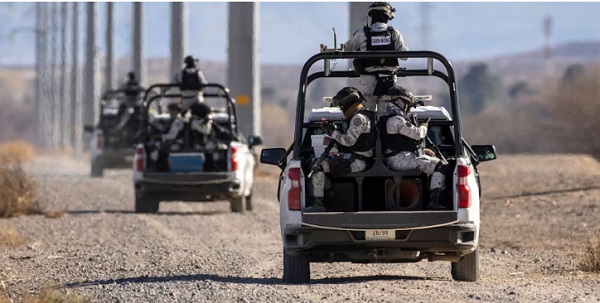illegal immigration
Will Mexico Face A Hot Shooting War With The Cartels?

From Todd Bensman for the Daily Wire
As Mexico prepares to position 10,000 troops between cartels and their drug money, odds are the lead will fly
The chosen political slogan of Mexico’s last and current president, “Abrazos, no balazos” (“Hugs, not Bullets”), is often embraced to describe official government policy toward the country’s ultra-violent drug-trafficking cartels. The beauty of this slogan is that it requires no explanation.
The reverse, however, “Bullets, not Hugs,” is probably up next whether Mexico likes it or not. President Donald Trump has just forced Mexican President Claudia Sheinbaum to capitulate to a threat of ruinous 25% trade tariffs on Mexican exports unless she uses military force to suppress the flow of fentanyl (and illegal immigrant smuggling) over the U.S. southern border. She’s deploying 10,000 troops to cartel country, right smack in the drug-trafficking lanes of Mexico’s far northern precincts along the U.S. border.
This deployment of Mexican troops, however, is quite different from previous ones, in which the main mission was to slow illegal immigration only, including during Trump’s first term and throughout the Biden term. For this one, the Trump mission demand is, as State Department Spokeswoman Tammy Bruce put it recently, that Mexico needs to “…dismantle transnational criminal organizations, halt illegal migration, and stem the flow of fentanyl and precursor chemicals from China.”
That American priority has just put Mexican forces in the crosshairs of the most sensitive cartel hotspot: the blood-soaked zone between heavily armed cartel forces and their money just across the U.S. border.

John Moore/Getty Images
As if this was not provocative enough on its own, a senior Trump official with direct knowledge told me bilateral plans call for at least some of the more trusted of Mexico’s forces to physically attack cartel-run narcotics depots that would include pre-smuggling fentanyl hubs inside Mexico.
Certain U.S. intelligence groups are working with the Mexican government “to give them an exact laydown. They say they’re going to target the narcotics. We’re literally still at the table.”
All of this should prove triggering, literally, to any of Mexico’s nine main cartels once the whole enterprise ramps up in earnest.
I have a good feel for what this set of circumstances portends. As a reporter for Hearst News in San Antonio, Texas, from 2006-2009, I regularly covered the exceptionally bloody civil drug war against the cartels that Felipe de Jesus Calderón Hinojosa (2006-2012) declared and which, after hundreds of thousands of Mexican casualties, spawned the popularly preferred “Hugs, not Bullets” policies of his successors. The U.S. partnered with Mexico throughout the war, providing targeting intelligence and billions of dollars to modernize its security forces. All of that was for a quest to stem the flow of illegal drugs into the United States.
But after six years of ferocious combat and widespread torture and assassination, Mexico retreated in almost total defeat. The drug flow may have dipped from time to time but it never stopped.
In the years since, I’ve often pondered whether Calderón and his successors should have trebled down when defeat seemed inevitable, as did former President George W. Bush during the Iraq war. When the chips were down amid calls for a humiliating U.S. withdrawal during the Iraq war, Bush famously turned the tables by deploying 30,000 more troops. With Mexico, however, disrupting fentanyl production and trafficking with the military will not be easy, and may very well spark another government-cartel war similar to 2006-2012.

John Moore/Getty Images
The stars and planets all seem to be aligning for more violence, including from an unexpected quarter: President Sheinbaum herself may be aching for this fight.
Rodrigo Nieto-Gomez, a Mexico-born and educated national security research professor for the Naval Postgraduate School in Monterey, California said Sheinbaum has installed anti-cartel Morena Party hardliners over much of Mexico’s state security apparatuses. This wing of her party, Nieto-Gomez explained, has been spoiling to shed the “Hugs, not bullets” policy for a good hard fight with the cartels.
Trump is now providing a “top-cover” excuse for them to finally exert the military pressure they’ve been wanting.
“Trump’s actions have temporarily tilted the playing field in favor of Morena,” Nieto-Gomez said. “With the right philosophy and the right level of American support, we may see a different type of violence in Mexico.”
Perhaps a worthy achievable goal for Mexican military fireworks is that it forces a sort of devil’s truce where the cartels, whose leaders are the most consummate and pragmatic of capitalists, ultimately agree to voluntarily quit fentanyl altogether as a good business decision — if the other drugs are allowed to roll in as usual. After all, when the operatives are shooting and dying, they’re spending rather than earning.
What seems certain, however, is that Trump’s inevitable following through on his campaign promises to suppress fentanyl ups the chances of a conflict between the Mexican military and the cartels. No doubt the cartels are now feeling uncharacteristically pinched these days on many other fronts thanks to Trump’s return.

John Moore/Getty Images
Trump has asked his Secretary of State to designate them as foreign terrorist organizations, which would open authorities for America and its allies to seize assets and prosecute banks and people who work with the cartels on serious “material support” crimes. To isolate and weaken them where it counts, in the pocketbook, and disrupt their global operations.
And, of course, Trump has all but killed the biggest cash cow those cartels have seen in years by shuttering the southern border almost hermetically in a matter of days. Their smugglers are moving probably fewer than 500 illegal immigrants a day now, most of them caught and deported right away, compared to 14,000 a day last December. Those numbers are a catastrophe and should drive the cartels to invest everything they have in drug trafficking again.
Because they are now free from babysitting and processing illegal migrants all day long, Border Patrol is back on the drug traffickers full force and they have help, the U.S. military is down there glassing the landscape and using surveillance assets to spot the traffickers.
Some of the cartels were already so frustrated their leaders approved the use of drones to attack U.S. agents standing in the way of drug loads. Cases of firearms attacks on Border Patrol are rising.
Now Mexico’s going to put 10,000 troops in between them and their money?
If she is not already, Sheinbaum should be preparing for the worst right about now. President Trump absolutely expects some kind of real action — with demonstrable results — or else he’ll push that tariff button. She’s under pressure right now to produce something, anything, whether for show or not. And the cartels are ever ready to go to war.
Thanks to former President Joe Biden’s mass migration program, it could very well happen, because now the impulsive, brazen, money-hungry cartels are are extremely well-armed from the billions they all earned over the past four years.

John Moore/Getty Images
Sheinbaum undoubtedly discerns the dangers here and will have to tread carefully between appeasing Trump and sparking another all-out civil war, which many in the United States believe is long overdue. And maybe it is. She and all the cartel leaders would probably feel lucky to cap things down to merely a “splendid little war” like the 1898 Spanish-American war.
But President Trump knows the art of the deal often pivots on what’s good business for everyone involved.
Mexico’s 2006-2012 war shows the cartels will more than likely survive whatever fireworks are coming, if any. Trump may make them realize sooner rather than later that they just have to give up the fentanyl.
* * *
Todd Bensman is a Senior National Security Fellow at the Center for Immigration Studies and a two-time National Press Club award winner. He is a graduate of the University of Missouri School of Journalism and a 23-year veteran newspaper reporter. He is the author of “America’s Covert Border War,” and “Overrun: How Joe Biden Unleashed the Greatest Border Crisis in U.S. History.”
illegal immigration
US Notes 2.5 million illegals out and counting

President Trump’s Department of Homeland Security is marking what officials are calling a landmark moment in U.S. immigration enforcement, announcing Wednesday that more than 2.5 million illegal aliens have now left the country since Trump returned to the Oval Office in January. DHS Secretary Kristi Noem said the surge reflects a sweeping, sustained crackdown driven by Immigration and Customs Enforcement teams that — according to internal tallies — have already removed more than 605,000 illegal aliens, most of whom were facing criminal charges or carrying prior convictions. Nearly two million more have opted to self-deport, a wave Noem attributes to stepped-up enforcement and the administration’s aggressive public messaging. She again urged those still in the country illegally to use the government’s CBP Home app, which offers a free one-way flight and a $1,000 stipend to expedite departure.
Senior DHS officials say arrests have climbed as well, with almost 600,000 illegal aliens taken into custody since January 20. “Illegal aliens are hearing our message to leave now,” DHS official McLaughlin said this week. “They know if they don’t, we will find them, we will arrest them, and they will never return.”
The administration argues the impact is being felt far beyond immigration courts and detention facilities, pointing to the U.S. housing market as one of the clearest signs of change. For six straight months, DHS says not a single illegal alien has been released into the interior from the southern border — a dramatic shift after years of mass inflows under President Biden. That decline, they say, is finally filtering into rent and home-price data after years of punishing increases.
Housing and Urban Development Secretary Scott Turner said Americans have now seen four consecutive months of rent decreases — the first sustained drop in years — as fewer illegal aliens compete for housing. Vice President JD Vance emphasized the connection even more bluntly: “The connection between illegal immigration and skyrocketing housing costs is as clear as day. We are proud to be moving in the right direction. Still so much to do.”
Research abroad and at home backs up the administration’s argument. Economists in Denmark released findings earlier this year showing that a one-percentage-point rise in local immigration over a five-year period drove private rental prices up roughly 6 percent and home prices up about 11 percent. The Center for Immigration Studies presented similar data to Congress last year, with researcher Steven Camarota testifying that a 5-percentage-point increase in a metro area’s recent-immigrant share was tied to a 12-percent rise in rent for U.S.-born households.
As DHS leaders frame it, Trump’s second-term enforcement machine is reshaping both border policy and household budgets — an approach they say is finally delivering relief to Americans who spent years squeezed by soaring housing costs and unchecked migration.
illegal immigration
EXCLUSIVE: Canadian groups, First Nation police support stronger border security

First Nation police chiefs join Texas Department of Public Safety marine units to patrol the Rio Grande River in Hidalgo County, Texas. L-R: Dwayne Zacharie, President of the First Nations Chiefs of Police Association, Ranatiiostha Swamp, Chief of Police of the Akwesasne Mohawk Territory, Brooks County Sheriff Benny Martinez, Jamie Tronnes, Center for North American Prosperity and Security, Goliad County Sheriff Roy Boyd. Photo: Bethany Blankley for The Center Square
From The Center Square
By
Despite Canadian officials arguing that the “Canada-U.S. border is the best-managed and most secure border in the world,” some Canadian groups and First Nation tribal police chiefs disagree.
This week, First Nation representatives traveled to Texas for the first time in U.S.-Canadian history to find ways to implement stronger border security measures at the U.S.-Canada border, including joining an Operation Lone Start Task Force, The Center Square exclusively reported.
Part of the problem is getting law enforcement, elected officials and the general public to understand the reality that Mexican cartels and transnational criminal organizations are operating in Canada; another stems from Trudeau administration visa policies, they argue.
When it comes to public perception, “If you tell Canadians we have a cartel problem, they’ll laugh at you. They don’t believe it. If you tell them we have a gang problem, they will absolutely agree with you 100%. They don’t think that gangs and cartels are the same thing. They don’t see the Hells Angels as equal to the Sinaloa Cartel because” the biker gang is visible, wearing vests out on the streets and cartel operatives aren’t, Jamie Tronnes, executive director of the Center of North American Prosperity and Security, told The Center Square in an exclusive interview.
The center is a US-based project of the MacDonald-Laurier Institute, the largest think tank in Canada. Tronnes previously served as a special assistant to the cabinet minister responsible for immigration and has a background in counterterrorism. She joined First Nation police chiefs to meet with Texas law enforcement and officials this week.
Another Canadian group, Future Borders Coalition, argues, “Canada has become a critical hub for transnational organized crime, with networks operating through its ports, banks, and border communities.” The Sinaloa and Jalisco New Generation Mexican cartels control the fentanyl, methamphetamine and cocaine business in Canada, partnering with local gangs like the Hells Angels and Chinese Communist Party (CCP)-linked actors, who launder profits through casinos, real estate, and shell companies in Vancouver and Toronto, Ammon Blair, a senior fellow at the Texas Public Policy Foundation, and others said at a coalition event prior to First Nation police chiefs and Tronnes coming to Texas.
“The ’Ndrangheta (Italian Mafia) maintains powerful laundering and import operations in Ontario and Quebec, while MS-13 and similar Central American gangs facilitate human smuggling and enforcement. Financial networks tied to Hezbollah and other Middle Eastern groups support laundering and logistics for these criminal alliances,” the coalition reports.
“Together, they form interconnected, technology-driven enterprises that exploit global shipping, cryptocurrency, and AI-enabled communications to traffic whatever yields profit – narcotics, weapons, tobacco, or people. Taking advantage of Canada’s lenient disclosure laws, fragmented jurisdictions, and weak cross-border coordination, these groups have embedded themselves within legitimate sectors, turning Canada into both a transit corridor and safe haven for organized crime,” the coalition reports.
Some First Nation reservations impacted by transnational crime straddle the U.S.-Canada border. One is the Akwesasne Mohawk Reservation, located in Ontario, Quebec, and in two upstate New York counties, where human smuggling and transnational crime is occurring, The Center Square reported. Another is the Tsawwassen First Nation (TWA) Reservation, located in a coastal region south of Vancouver in British Columbia stretching to Point Roberts in Washington state, which operates a ferry along a major smuggling corridor.
Some First Nation reservations like the TWA are suffering from CCP organized crime, Tronnes said. Coastal residents observe smugglers crossing their back yards, going through the reserve; along Canada’s western border, “a lot of fentanyl is being sent out to Asia but it’s also being made in Canada,” Tronnes said.
Transnational criminal activity went largely unchecked under the Trudeau government, during which “border security, national security and national defense were not primary concerns,” Tronnes told The Center Square. “It’s not to say they weren’t concerns, but they weren’t top of mind concerns. The Trudeau government preferred to focus on things like climate change, international human rights issues, a feminist foreign policy type of situation where they were looking more at virtue signaling rather than securing the country.”
Under the Trudeau administration, the greatest number of illegal border crossers, including Canadians, and the greatest number of known, suspected terrorists (KSTs) were reported at the U.S.-Canada border in U.S. history, The Center Square first reported. They include an Iranian with terrorist ties living in Canada and a Canadian woman who tried to poison President Donald Trump, The Center Square reported.
“Had it been a priority for the government to really crack down and provide resources for national security,” federal, provincial and First Nation law enforcement would be better equipped, funded and staffed, Tronnes said. “They would have better ways to understand what’s really happening at the border.”
In February, President Donald Trump for the first time in U.S. history declared a national emergency at the northern border and ordered U.S. military intervention. Months later, his administration acknowledged the majority of fentanyl and KSTs were coming from Canada, The Center Square reported.
Under a new government and in response to pressure from Trump, Canada proposed a $1.3 billion border plan. However, more is needed, the groups argue, including modernizing border technology and an analytics infrastructure, reforming disclosure and privacy rules to enable intelligence sharing, and recognizing and fully funding First Nation police, designating them as essential services and essential to border security.
“National security doesn’t exist without First Nation policing at the border,” Dwayne Zacharie, First Nations Chiefs of Police president, told The Center Square.
-

 International2 days ago
International2 days agoCommunist China arrests hundreds of Christians just days before Christmas
-

 International2 days ago
International2 days agoGeorgia county admits illegally certifying 315k ballots in 2020 presidential election
-

 Business2 days ago
Business2 days agoSome Of The Wackiest Things Featured In Rand Paul’s New Report Alleging $1,639,135,969,608 In Gov’t Waste
-

 Energy2 days ago
Energy2 days ago‘The electric story is over’
-

 Alberta2 days ago
Alberta2 days agoCalgary’s new city council votes to ban foreign flags at government buildings
-

 Alberta2 days ago
Alberta2 days agoA Christmas wish list for health-care reform
-

 Alberta1 day ago
Alberta1 day agoOttawa-Alberta agreement may produce oligopoly in the oilsands
-

 Energy1 day ago
Energy1 day agoWestern Canada’s supply chain for Santa Claus









